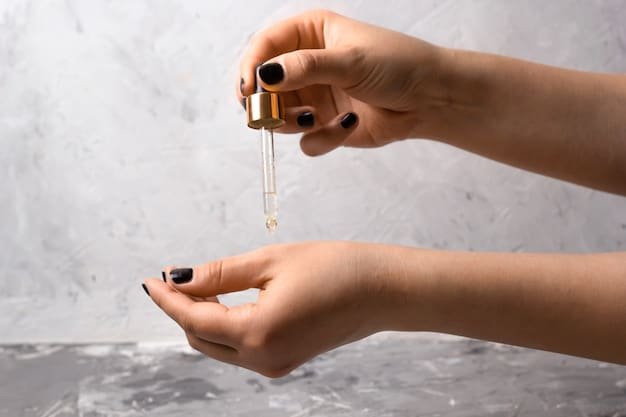Combatting Oily Skin: Your 2025 Step-by-Step Guide

Combatting oily skin in 2025 requires a strategic approach encompassing proper cleansing, targeted treatments, and lifestyle adjustments to achieve a matte and healthy complexion. This guide provides a step-by-step plan for managing oil production and promoting balanced skin.
Dealing with oily skin can feel like a never-ending battle, but achieving a matte, healthy complexion is entirely possible. Our comprehensive guide, Combatting Oily Skin: A Step-by-Step Guide to a Matte Finish in 2025, is designed to help you take control and reveal your best skin yet.
Understanding Oily Skin: Why It Happens
Oily skin occurs when the sebaceous glands in your skin produce excessive sebum, a natural oil that keeps skin hydrated. While sebum is essential for skin health, its overproduction can lead to a shiny appearance, enlarged pores, and breakouts. Understanding the root causes of oily skin is the first step in effectively managing it.
Genetic Predisposition
Genetics play a significant role in determining your skin type. If oily skin runs in your family, you’re more likely to experience it yourself.
Hormonal Fluctuations
Hormonal changes, such as those that occur during puberty, menstruation, pregnancy, or menopause, can stimulate sebum production, leading to increased oiliness.
- Dietary Factors: A diet high in processed foods, sugar, and unhealthy fats can contribute to inflammation and increased sebum production.
- Environmental Conditions: Hot and humid weather can exacerbate oily skin, as heat stimulates the sebaceous glands.
- Improper Skincare: Using harsh or comedogenic skincare products can strip the skin of its natural oils, causing it to overproduce sebum to compensate.
By understanding these factors, you can begin to identify the specific triggers for your oily skin and tailor your skincare routine accordingly. This personalized approach is key to achieving a balanced, matte complexion.
Step 1: Gentle and Effective Cleansing
Cleansing is the cornerstone of any skincare routine, particularly for oily skin. The goal is to remove excess oil, dirt, and impurities without stripping the skin of its natural moisture, which can lead to increased oil production. Choosing the right cleanser and using it correctly is crucial.
Choosing the Right Cleanser
Opt for a gentle, oil-free cleanser specifically formulated for oily or combination skin. Look for ingredients like salicylic acid or tea tree oil, which can help unclog pores and reduce inflammation.
The Double Cleansing Method
Consider double cleansing, especially at night. Start with an oil-based cleanser to remove makeup and sunscreen, followed by a water-based cleanser to remove any remaining residue.

- Morning Routine: Cleanse your face in the morning to remove any oil that accumulated overnight.
- Evening Routine: Always cleanse your face before bed to remove makeup, dirt, and pollutants.
- Lukewarm Water: Use lukewarm water to wash your face, as hot water can strip the skin of its natural oils and cause irritation.
Consistent and gentle cleansing can significantly reduce oiliness and prevent breakouts. Remember to pat your skin dry with a clean towel after cleansing, rather than rubbing it, which can irritate the skin.
Step 2: Exfoliation for Clearer Skin
Exfoliation is a crucial step in combatting oily skin, as it helps to remove dead skin cells that can clog pores and lead to breakouts. Regular exfoliation can also improve skin texture and promote a brighter complexion. Choosing the right exfoliation method is essential to avoid irritation.
Chemical Exfoliation
Chemical exfoliants, such as AHAs (alpha-hydroxy acids) and BHAs (beta-hydroxy acids), are effective at removing dead skin cells and unclogging pores. Salicylic acid is a BHA particularly beneficial for oily skin due to its ability to penetrate oil glands.
Physical Exfoliation
Physical exfoliants, such as scrubs and cleansing brushes, can also be used to remove dead skin cells. However, it’s essential to use them gently to avoid irritating the skin.
- Frequency: Exfoliate 1-2 times per week to avoid over-exfoliating and irritating the skin.
- Patch Test: Before using a new exfoliant, perform a patch test on a small area of your skin to check for any adverse reactions.
- Avoid Harsh Scrubs: Opt for gentle exfoliating scrubs with small, round beads to minimize irritation.
Incorporating exfoliation into your skincare routine can significantly improve the appearance and texture of oily skin. Be sure to follow up with a moisturizer to keep your skin hydrated and balanced.
Step 3: Targeted Treatments for Oil Control
Targeted treatments are essential for addressing specific concerns associated with oily skin, such as excess oil production, enlarged pores, and breakouts. These treatments often contain active ingredients that work to regulate sebum production and improve skin clarity. Incorporating these into your routine can make a noticeable difference.
Use a Niacinamide Serum
Niacinamide is a form of vitamin B3 that can help regulate sebum production, reduce inflammation, and minimize the appearance of pores. It’s a versatile ingredient suitable for most skin types.
Incorporate Retinoids
Retinoids, such as retinol and tretinoin, can help to reduce oil production, unclog pores, and improve skin texture. Start with a low concentration and gradually increase as tolerated.
- Spot Treatments: Use spot treatments containing benzoyl peroxide or salicylic acid to target individual breakouts.
- Clay Masks: Apply a clay mask 1-2 times per week to absorb excess oil and impurities from the skin.
- Lightweight Moisturizers: Use a lightweight, oil-free moisturizer to keep your skin hydrated without clogging pores.
By incorporating targeted treatments into your skincare routine, you can effectively manage oil production and improve the overall health and appearance of your skin. Consistency is key, so stick with your routine and be patient as you wait for results.

Step 4: The Right Moisturizer and Sunscreen
Many people with oily skin mistakenly believe they don’t need moisturizer or sunscreen, but these products are essential for maintaining healthy, balanced skin. Skipping these steps can lead to dehydration and increased oil production. Choosing the right formulas is key to keeping your skin hydrated and protected without feeling greasy.
Oil-Free Moisturizers
Opt for oil-free, non-comedogenic moisturizers that won’t clog pores. Look for lightweight formulas that contain humectants like hyaluronic acid and glycerin, which attract moisture to the skin without adding oil.
Sunscreen is Key
Sunscreen is non-negotiable, regardless of your skin type. Choose an oil-free, broad-spectrum sunscreen with an SPF of 30 or higher to protect your skin from sun damage.
- Gel-Based Formulas: Gel-based moisturizers are lightweight and absorb quickly, making them ideal for oily skin.
- Mineral Sunscreens: Mineral sunscreens containing zinc oxide or titanium dioxide are less likely to clog pores than chemical sunscreens.
- Application: Apply moisturizer and sunscreen every morning, even on cloudy days.
Hydration and sun protection are vital for maintaining healthy, balanced skin. By choosing the right products and incorporating them into your daily routine, you can keep your skin looking its best.
Step 5: Lifestyle Adjustments for Long-Term Control
While skincare products play a significant role in managing oily skin, lifestyle adjustments are equally important for long-term control. Factors like diet, stress, and sleep can all impact sebum production and skin health. Making positive changes in these areas can complement your skincare routine and help you achieve a consistently matte complexion.
Dietary Changes
A diet rich in processed foods, sugar, and unhealthy fats can contribute to inflammation and increased sebum production. Focus on incorporating whole, unprocessed foods into your diet, such as fruits, vegetables, lean proteins, and healthy fats.
Stress Management
Stress can trigger hormonal imbalances that lead to increased oil production. Find healthy ways to manage stress, such as exercise, meditation, or spending time in nature.
- Stay Hydrated: Drink plenty of water throughout the day to keep your skin hydrated and flush out toxins.
- Regular Exercise: Exercise can help regulate hormone levels and reduce stress, benefiting your skin.
- Adequate Sleep: Aim for 7-8 hours of sleep per night to allow your skin to repair and regenerate.
By making these lifestyle adjustments, you can support your skincare routine and achieve long-term control over oily skin. Remember, consistency is key, so stick with your healthy habits for the best results.
Step 6: Makeup Tips for Oily Skin
Makeup can be both a friend and foe when you have oily skin. While it can help to even out your complexion and conceal imperfections, using the wrong products or application techniques can exacerbate oiliness and lead to breakouts. Here’s how you can make makeup work for you, not against you.
Start with a Primer
Use a mattifying primer to create a smooth base for your makeup and help control oil production throughout the day. Look for primers that contain ingredients like silica or charcoal.
Choose Oil-Free Makeup
Opt for oil-free, non-comedogenic foundations, concealers, and powders. Mineral makeup can also be a good choice, as it’s typically lightweight and doesn’t contain pore-clogging ingredients.
- Blotting Papers: Keep blotting papers on hand to absorb excess oil throughout the day without disturbing your makeup.
- Setting Spray: Use a setting spray to help your makeup stay in place and prevent it from sliding off due to oiliness.
- Avoid Heavy Coverage: Heavy, full-coverage makeup can clog pores and exacerbate breakouts. Opt for lighter coverage options instead.
With the right makeup products and techniques, you can achieve a flawless, matte finish without compromising the health of your skin. Remember to always remove your makeup thoroughly before bed to prevent clogged pores and breakouts.
| Key Point | Brief Description |
|---|---|
| 💧 Gentle Cleansing | Use oil-free cleanser twice daily to remove excess oil without stripping skin. |
| ✨ Regular Exfoliation | Exfoliate 1-2 times a week to remove dead skin cells and unclog pores. |
| 🧴 Targeted Treatments | Incorporate serums with niacinamide or retinoids to control oil and improve texture. |
| ☀️ Oil-Free Sunscreen | Always use an oil-free, broad-spectrum sunscreen to protect your skin daily. |
Frequently Asked Questions
▼
Yes, you can. Over-washing can strip your skin of its natural oils, leading to increased oil production as your skin tries to compensate. Limit washing to twice a day.
▼
No, not all oils are bad. Certain non-comedogenic oils like jojoba or grapeseed oil can actually benefit oily skin by balancing oil production and providing hydration.
▼
Using a clay mask once or twice a week is generally recommended for oily skin. Overuse can dry out the skin, so listen to your skin’s needs.
▼
Yes, moisturizing is essential. Choose a lightweight, oil-free moisturizer to hydrate your skin without clogging pores or adding extra oil.
▼
Yes, diet can play a significant role. High-glycemic foods and dairy can increase inflammation and sebum production, so a balanced diet is beneficial.
Conclusion
Combatting oily skin requires a comprehensive approach that combines a consistent skincare routine with healthy lifestyle habits. By following these steps, you can effectively manage oil production, minimize breakouts, and achieve a matte, healthy complexion in 2025 and beyond.





